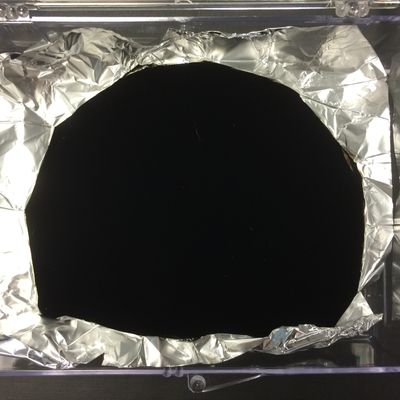
The darkest shade of black isn’t a pigment at all — it’s a material called Vantablack that’s made up of billions of carbon nanotubes clustered together, and it reflects so little light that were you to spread it over a piece of wrinkled tinfoil, the wrinkles would disappear. That’s because Vantablack absorbs almost all light reflected onto it, which robs the human eye of the ability to perceive depth.
Vantablack has been around since 2014, but Surrey NanoSystems, the British company that produces Vantablack, announced last week that it’s now available in a spray form called S-VIS. And although there’s no explicit use for it yet, the company’s chief technology officer told the New York Times its prospective uses include “ultrablack coatings (think camouflage technology), wiring in microchips, enhancing the strength of components in the aerospace industry, touch screens” and “ultralight wiring, to name a few.” But Vantablack is also making waves in the art world — Anish Kapoor, the sculptor who designed Chicago’s Cloud Gate, recently secured exclusive rights to the material, much to other artists’ chagrin. “The material is astonishing, so deeply black that your eyes can’t really see it at all,” Kapoor told Dazed. “It’s like staring into the kind of black hole found in outer space.”
In making that claim, however, Kapoor seems to misinterpret exactly what Vantablack does. The material itself, and objects covered in it, are perfectly visible to the naked eye. “You can see it just fine,” said Dr. Qasim Zaidi of the SUNY College of Optometry. “If I cut a circular patch out of this material, you will see that it’s a black circular patch. What you can’t see are variations inside it: folds, wrinkles, other shapes. There’s no shading to tell you what’s going on.”
Still, Vantablack is “a pretty amazing material,” Zaidi said. “We see things because of the shading on them, but Vantablack takes away that shading. It reflects less than one-third of a hundredth of a percent of light shone at it.” Zaidi is quick to say he’s not a physicist, so he can’t explain the exact mechanism behind Vantablack’s powers of absorption, but he posits it’s because the nanotubes it’s made up of are so tiny. “They’re about as thick as a wave of light, which is less than one millionth of a meter, so they can guide light,” he said. “My suspicion is that they guide light down themselves, and it never comes back out.”
Kapoor, who’s known for working with reflections, planes, and voids, has reportedly been working with Vantablack since it was first created. And although he has yet to unveil a work that incorporates the material, Zaidi suspects he’ll use it to make curved surfaces appear flat. “It’ll be completely disorienting,” he said. “It’s not an easy material to work with.”




